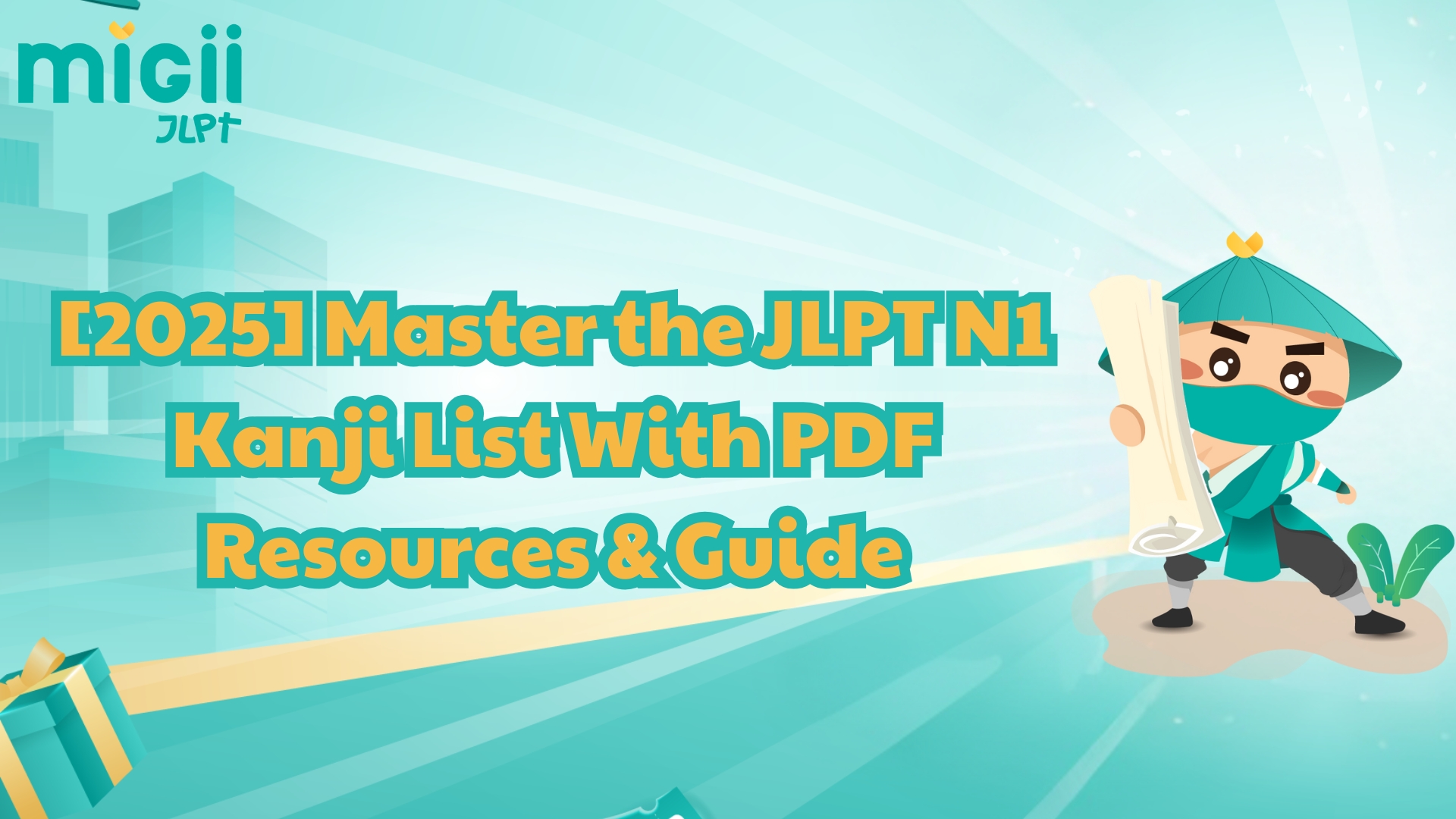JLPT N5 adverbs are essential for expressing frequency, degree, and manner in basic Japanese sentences. Mastering them helps you boost your grammar and listening scores. This article offers a free JLPT N5 adverbs PDF and study tips—read on to download and learn effectively!
What Are Adverbs in JLPT N5?
In Japanese, adverbs (副詞 – fukushi) are words that describe how, when, how often, or to what extent an action happens. For JLPT N5 adverbs, these words are simple yet frequently used in daily conversation and appear in grammar and listening questions on the exam.
Adverbs in JLPT N5 typically modify verbs, adjectives, or even other adverbs. They help add nuance to your expression—for example, showing frequency (よく – often), degree (とても – very), quantity (たくさん – a lot), or time (もう – already).
Here are some common JLPT N5 adverbs:
|
Japanese |
Romaji |
Meaning |
|
よく |
yoku |
often |
|
たくさん |
takusan |
a lot |
|
とても |
totemo |
very |
|
もう |
mou |
already |
|
まだ |
mada |
not yet |
|
すぐ |
sugu |
immediately |
|
ゆっくり |
yukkuri |
slowly |
These adverbs are used in basic sentence patterns like:
- 私はよくテレビを見ます。 (I often watch TV.)
- このケーキはとてもおいしいです。 (This cake is very delicious.)
Learning jlpt n5 adverbs not only helps you understand test content more easily but also improves your ability to speak and write naturally in Japanese.
By familiarizing yourself with these basic adverbs, you’ll gain confidence in both understanding and producing everyday Japanese. Let’s move on to explore why you should prioritize learning them early!
Learn more JLPT N5 Adverbs with clear examples in this N5 theory guide.
Why You Should Learn JLPT N5 Adverbs Early
Mastering JLPT N5 adverbs early in your Japanese learning journey can give you a strong advantage—not only in passing the exam but also in real-world communication.
They appear frequently in the JLPT N5 exam
Many listening (聴解 – choukai) and reading (読解 – dokkai) questions include adverbs to test your comprehension of nuance. Words like よく (often), たくさん (a lot), or すぐ (immediately) can completely change the meaning of a sentence.
If you miss the adverb, you might misunderstand the whole sentence or choose the wrong answer.
They improve sentence clarity and fluency
Adverbs help express how, how much, or when something happens. For example:
- かれはたくさんたべました。 (He ate a lot.)
- 私はまだしゅくだいをしていません。 (I haven’t done my homework yet.)
Such sentences are clearer, more natural, and closer to native usage—even at the N5 level. The sooner you get used to using adverbs, the smoother your speaking and writing will be.
They support grammar understanding
Adverbs reinforce key grammar points such as verb forms, tense, and sentence structure. Learning adverbs in context helps you internalize common patterns like:
- もう~ました (Already did…)
- まだ~ていません (Have not yet…)
These structures are not only grammar essentials for JLPT N5 but also foundations for higher levels.
They are easy to remember but easy to overlook
JLPT N5 adverbs are usually short, simple words, which makes them easy to learn—but learners often underestimate their importance. By prioritizing them early, you’ll avoid last-minute cramming and gain an edge in listening and speaking tasks.
Free JLPT N5 Adverbs PDF Download
To help learners master JLPT N5 adverbs easily and efficiently, we’ve created a free, downloadable PDF that organizes adverbs by usage and meaning—making your study experience smoother and more effective.
Adverbs of Frequency – How Often Something Happens
|
Japanese (日本語) |
Romaji |
English Meaning |
Example Sentence |
|
よく |
yoku |
often |
よく日本の映画を見ます。 (I often watch Japanese movies.) |
|
ときどき |
tokidoki |
sometimes |
ときどき外で食べます。 (I sometimes eat out.) |
|
たまに |
tamani |
occasionally |
たまに友だちに会います。 (I occasionally meet friends.) |
|
いつも |
itsumo |
always |
彼はいつも早く起きます。 (He always wakes up early.) |
|
たいてい |
taitei |
usually |
たいてい朝ごはんを食べます。 (I usually eat breakfast.) |
|
ぜんぜん |
zenzen |
never (with negative verb) |
ぜんぜんテレビを見ません。 (I never watch TV.) |
Adverbs of Degree – How Much or How Strong
|
Japanese (日本語) |
Romaji |
English Meaning |
Example Sentence |
|
とても |
totemo |
very |
このケーキはとてもおいしいです。 (This cake is very delicious.) |
|
ちょっと |
chotto |
a little / a bit |
ちょっとまってください。 (Please wait a moment.) |
|
かなり |
kanari |
quite / fairly / considerably |
かなりむずかしいテストでした。 (It was a fairly difficult test.) |
|
ぜんぜん |
zenzen |
not at all (with neg. verb) |
ぜんぜんわかりません。 (I don't understand at all.) |
|
あまり |
amari |
not very (with neg. verb) |
あまりたべません。 (I don't eat much.) |
|
すごく |
sugoku |
extremely / incredibly |
すごくたのしかったです。 (It was incredibly fun.) |
|
まあまあ |
maamaa |
so-so / okay / not bad |
まあまあおいしいです。 (It's okay—not bad.) |
|
ほんとうに |
hontou ni |
really / truly |
ほんとうにありがとう。 (Thank you very much.) |
|
けっこう |
kekkou |
fairly / pretty |
この映画はけっこうよかった。 (The movie was pretty good.) |
|
わりと |
warito |
relatively / comparatively |
わりとかんたんでした。 (It was relatively easy.) |
Adverbs of Time – When Something Happens
|
Japanese (日本語) |
Romaji |
English Meaning |
Example Sentence |
|
もう |
mou |
already |
もう食べました。 (I already ate.) |
|
まだ |
mada |
not yet / still |
まだしゅくだいをしていません。 (I haven’t done my homework yet.) |
|
すぐ |
sugu |
immediately / soon |
すぐ行きます。 (I’ll go right away.) |
|
ときどき |
tokidoki |
sometimes |
ときどき雨がふります。 (It sometimes rains.) |
|
たった今 |
tatta ima |
just now |
たった今出かけました。 (He just left.) |
|
いつも |
itsumo |
always |
いつもこの店に来ます。 (I always come to this shop.) |
|
きのう |
kinou |
yesterday |
きのう勉強しました。 (I studied yesterday.) |
|
今日 |
kyou |
today |
今日テストがあります。 (There is a test today.) |
|
あした |
ashita |
tomorrow |
あした日本に行きます。 (I will go to Japan tomorrow.) |
|
もうすぐ |
mousugu |
very soon / shortly |
もうすぐ始まります。 (It will start very soon.) |
Adverbs of Manner – how an action is done
|
Japanese (日本語) |
Romaji |
English Meaning |
Example Sentence |
|
ゆっくり |
yukkuri |
slowly |
ゆっくり話してください。 (Please speak slowly.) |
|
はっきり |
hakkiri |
clearly |
はっきり言ってください。 (Please say it clearly.) |
|
しっかり |
shikkari |
properly / firmly |
しっかり勉強します。 (I’ll study properly.) |
|
じょうずに |
jouzu ni |
skillfully |
日本語をじょうずに話します。 (He speaks Japanese skillfully.) |
|
たのしく |
tanoshiku |
happily / joyfully |
たのしく歌いました。 (They sang happily.) |
|
いっしょうけんめい |
isshoukenmei |
with all one's effort |
いっしょうけんめい働きます。 (I’ll work with all my effort.) |
|
ていねいに |
teinei ni |
politely / carefully |
ていねいに書いてください。 (Please write neatly.) |
|
ぐっすり |
gussuri |
soundly (sleep) |
ぐっすり寝ました。 (I slept soundly.) |
|
そっと |
sotto |
gently / softly |
ドアをそっと閉めてください。 (Please close the door gently.) |
|
すばやく |
subayaku |
quickly / swiftly |
すばやく動きました。 (He moved quickly.) |
Adverbs of Quantity – How Many or How Much
|
Japanese (日本語) |
Romaji |
English Meaning |
Example Sentence |
|
たくさん |
takusan |
a lot / many |
水をたくさん飲みました。 (I drank a lot of water.) |
|
すこし |
sukoshi |
a little / a few |
ごはんをすこし食べました。 (I ate a little rice.) |
|
おおぜい |
oozei |
many people |
おおぜいの人が来ました。 (Many people came.) |
|
いくつか |
ikutsuka |
several / some |
いくつか質問があります。 (I have several questions.) |
|
ほんのすこし |
hon no sukoshi |
just a little |
ほんのすこししか分かりません。 (I only understand just a little.) |
|
けっこう |
kekkou |
fairly / enough |
けっこう食べました。 (I ate enough.) |
|
ちょっとだけ |
chotto dake |
just a bit |
ちょっとだけ見せてください。 (Please show me just a little.) |
|
わずかに |
wazuka ni |
slightly / barely |
わずかに値段が上がりました。 (The price went up slightly.) |
|
もっと |
motto |
more |
もっと食べたいです。 (I want to eat more.) |
|
ほとんど |
hotondo |
almost / nearly all |
ほとんど終わりました。 (It's almost finished.) |
How to Study JLPT N5 Adverbs Effectively
Adverbs may seem like small words, but they play a big role in expressing nuance, time, and manner in Japanese. To master JLPT N5 adverbs, you need more than just memorization—you need the right methods. Here are proven strategies to help you study them effectively:
Learn in Context, Not in Isolation
Don’t just memorize lists. Study adverbs within full example sentences so you understand how they function in real conversations.
Example:
- たくさん = a lot
- Sentence: 水をたくさん飲みました。 (I drank a lot of water.)
This method improves both recognition and usage, especially in the listening and grammar sections of the JLPT N5.
Group Adverbs by Function or Meaning
As shown earlier, organizing adverbs into categories like frequency, degree, time, manner, and quantity helps you remember faster. This logical grouping creates mental associations and strengthens recall.
Use Flashcards with Spaced Repetition
Import adverbs into flashcard tools that support spaced repetition (e.g., Anki, Quizlet). These tools test you just before you’re likely to forget a word—making learning more efficient.
Each flashcard should include:
- The adverb in kana/kanji
- Romaji and English meaning
- One full example sentence
Practice with Listening and Reading
Watch simple Japanese videos, anime, or JLPT N5 listening materials and try to spot adverbs you’ve learned.
Example: Listen for words like もう, まだ, or すぐ in native dialogue.
Also, try to read short texts and underline any adverbs you find—this helps reinforce recognition in real contexts.
Use Adverbs in Writing and Speaking Practice
Create your own simple sentences using new adverbs. Say them aloud or write short diary entries using at least 3 adverbs a day.
Example:
- 今日はとてもさむいです。 (It’s very cold today.)
- まだ朝ごはんを食べていません。 (I haven’t eaten breakfast yet.)
The more you use adverbs, the faster they’ll become part of your natural Japanese.
Track Progress with a Personal Adverb Checklist
Use a printable or digital checklist of JLPT N5 adverbs and mark:
- “Recognized” when you understand it in context
- “Used” when you can use it in a sentence
This helps you visually measure your improvement.
FAQ - JLPT N5 Adverbs
How many adverbs do I need to know for JLPT N5?
There’s no official number, but most study guides recommend learning around 40–60 essential JLPT N5 adverbs. These adverbs often appear in grammar, listening, and reading sections of the test.
Looking for more study materials? Check out this JLPT document collection blog post for free PDFs and resources.
Are JLPT N5 adverbs hard to learn?
No. Most JLPT N5 adverbs are short, common, and easy to pronounce. Many are used in daily conversations and anime, which makes them easy to pick up with practice.
What’s the best way to memorize JLPT N5 adverbs?
The most effective way is to:
- Learn adverbs in context (with full sentences)
- Use flashcards with spaced repetition
- Practice using them in writing and speaking
- Group them by category: time, frequency, manner, etc.
Are adverbs tested directly in the JLPT N5 exam?
Yes. JLPT N5 adverbs often appear in:
- Grammar multiple-choice questions
- Listening scripts to test nuance (e.g., difference between "already" vs "not yet")
- Reading comprehension for sentence meaning
Can I find JLPT N5 adverbs in real-life Japanese use?
Absolutely. Many JLPT N5 adverbs are used in daily conversations, TV shows, and texts. Words like すぐ, たくさん, and ゆっくり are common and practical.
What’s the difference between an adverb and an adjective in Japanese?
- Adverbs (副詞) describe actions (verbs) or other adverbs.
e.g., ゆっくり話します。 (Speak slowly.) - Adjectives (形容詞) describe nouns.
e.g., ゆっくりな車 is grammatically incorrect.
In Japanese, adverbs are not conjugated, which makes them easier to use.
Conclusion
In summary, mastering JLPT N5 adverbs is essential for expressing time, frequency, and manner in basic Japanese. With our free and updated JLPT N5 Adverbs PDF (2025), you’ll gain a solid vocabulary foundation for the exam and real-life use. Ready to level up your Japanese? Start practicing now with Migii JLPT – your complete JLPT preparation platform!








